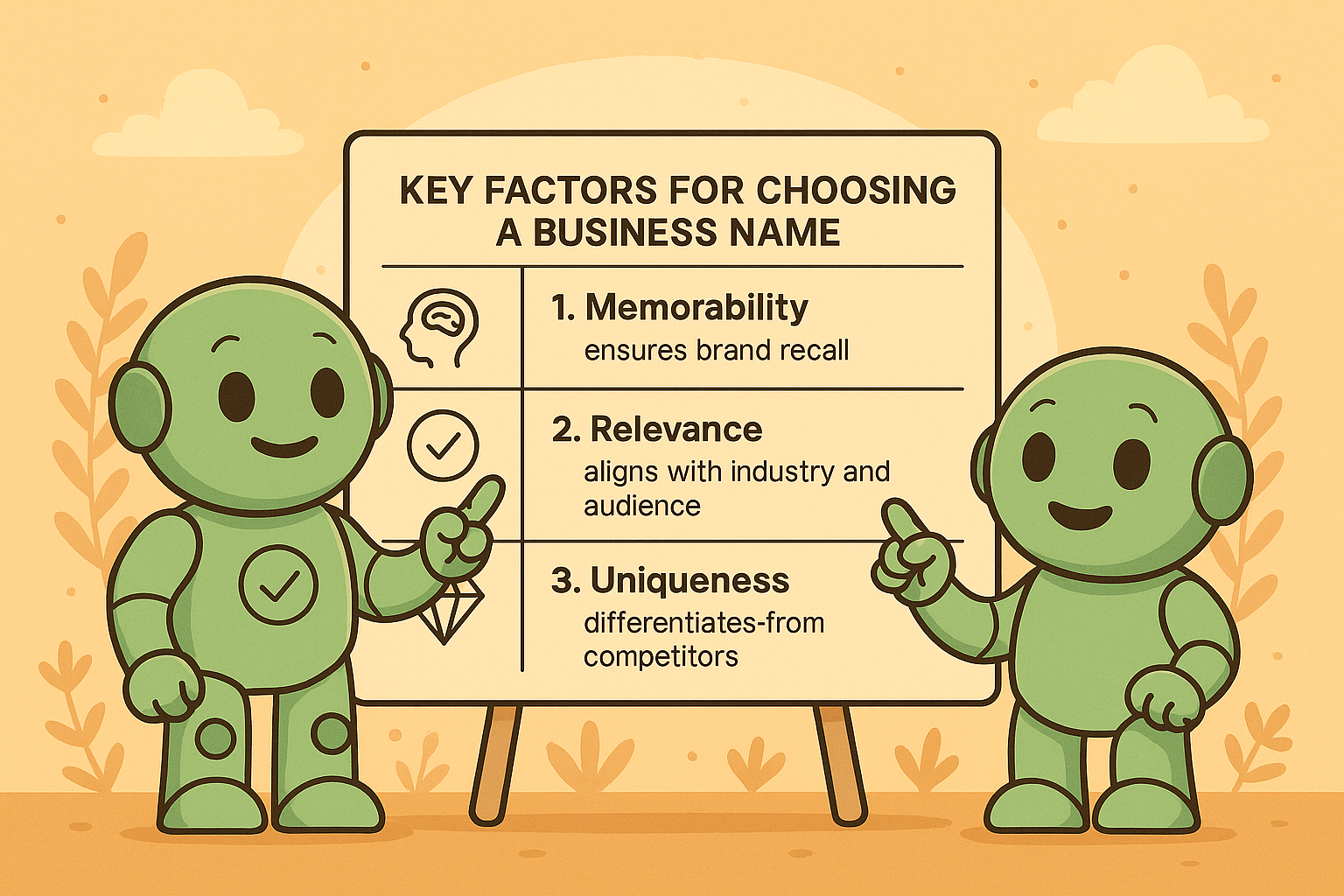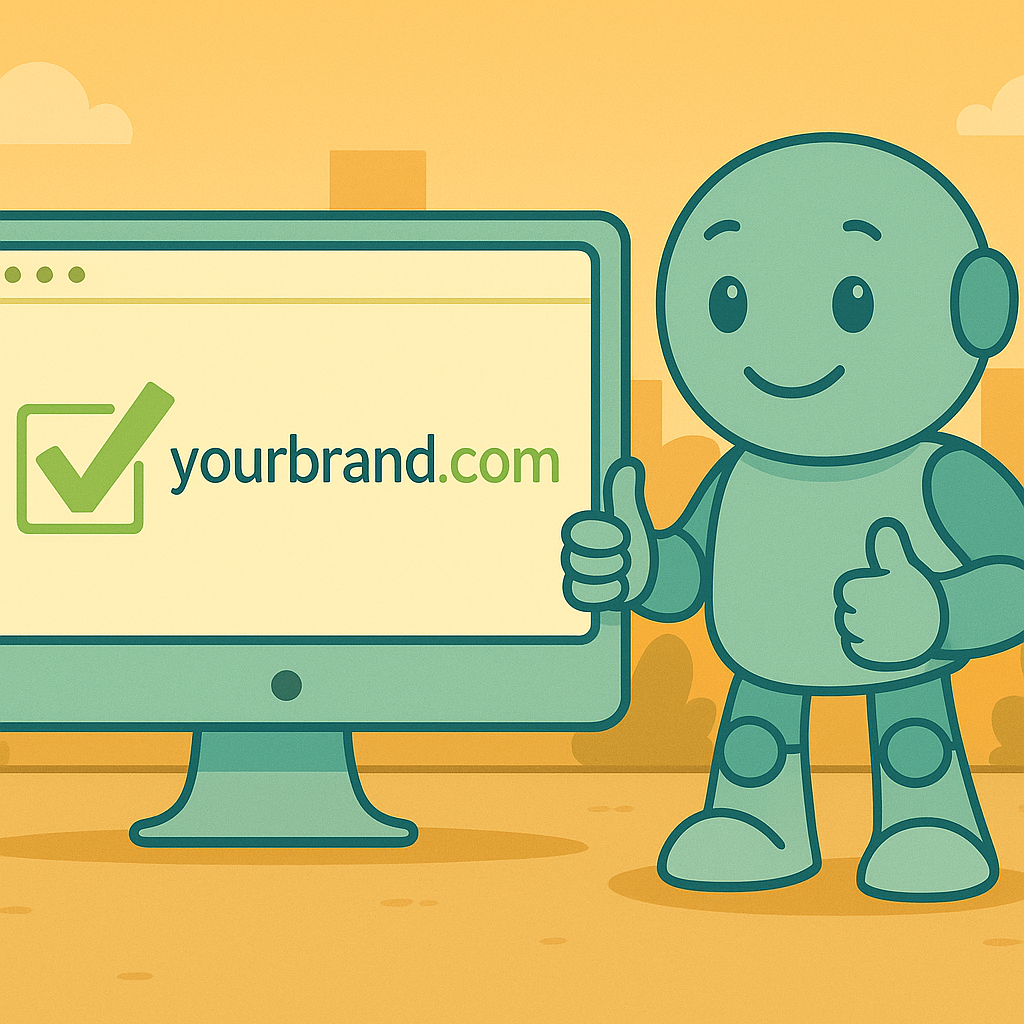How to Choose a Business Name That Always Stands Out
Why Getting Your Business Name Right Changes Everything

Your business name isn’t just a label slapped onto your company; it's the bedrock of your brand. It's the first thing people see, the word-of-mouth whisper that travels, and the anchor point for every single marketing campaign. Picking the right name can be the difference between immediate recognition and a constant uphill battle for visibility. I've chatted with so many entrepreneurs about this, some with amazing naming stories and others who’ve shared painful (and expensive) rebranding lessons. These conversations really highlight the significance of this seemingly simple decision.
For instance, one founder told me how their initial, super generic name made it almost impossible to cut through the noise. They wasted so much time and energy explaining what they actually did instead of letting their name do the talking. After rebranding with a more distinctive name, their marketing became significantly more effective. It proved what many already know: your name is constantly working for you, even when you're not actively promoting it.
A powerful business name also influences more than just customer perception. It impacts investor confidence, team morale, and even your own pride in your work. Think about it: a name that truly reflects your mission and values can inspire your employees and attract the best talent. A weak or confusing name? That can cause internal confusion and project a lack of professionalism.
In a world with roughly 359 million companies operating globally (as of 2023), choosing a business name is more crucial than ever. This number is way up from 328 million in 2020, showing just how vibrant and competitive the business landscape is. With an estimated 100 million new businesses launching each year, a unique and memorable name can truly set you apart. Discover more insights about business statistics here. This highlights the importance of not just finding a great name, but making sure it's available and legally protected.
But getting your business name right isn't just about dodging legal issues or fading into the background. It's about creating a name that embodies your brand and sets you up for long-term success. A well-chosen name becomes a valuable asset, boosting brand recognition, customer loyalty, and ultimately, your profits. In the next section, we’ll dive into the crucial research needed to avoid naming disasters and choose a name that truly resonates with your vision and helps you achieve your goals.
The Detective Work That Saves You From Naming Disasters

This infographic neatly sums up the three pillars of a killer business name: memorability, relevance, and uniqueness. Think of it like a three-legged stool – you need all three for it to stand strong. A memorable name sticks in people's minds, relevance speaks directly to your audience, and uniqueness helps you stand out from the crowd.
Picking a name might seem simple, but trust me, it’s way more than just brainstorming a few catchy phrases. You need to do your homework to avoid some serious headaches down the line. Imagine pouring your heart and soul (and budget!) into building your brand, only to find out someone else already owns the name.
This happened to a friend of mine. She launched a cool clothing line, and everything was going great… until the cease and desist letter arrived. She had to rebrand from scratch, which cost her a fortune and months of lost time. That's why due diligence is so crucial when choosing a business name. It's like detective work – you're searching for clues to uncover potential problems before they blow up your business.
Uncovering Potential Conflicts
Your first step is a good old-fashioned Trademark Search. Start simple: a Google search and a quick scan of social media platforms. Then, dive deeper into trademark databases. The WIPO Global Brand Database is a great resource, especially if you're thinking about expanding internationally. The global market is a jungle, and lots of companies protect their names with international trademarks.
Thinking globally from the get-go is super important, even if you're just starting locally. You never know where your business might take you, and it’s much easier (and cheaper) to address potential international trademark issues early on.
Another smart move is to research your competitors' naming strategies. This can give you some valuable insights into what works in your industry and might even reveal some untapped opportunities. Looking at what others are doing is a great way to learn and get inspired (without copying, of course!). Speaking of inspiration, you might find this helpful: Top Catchy Business Name Ideas to Spark Your Brand.
Before we go any further, let's look at some tools you can use to research your business name. The table below summarizes some key resources and their pros and cons.
Here’s a handy checklist to guide your research:
| Research Area | Primary Tools | Cost | Time Required | Priority Level |
|---|---|---|---|---|
| Domain Availability | GoDaddy, Namecheap | Varies | Low | High |
| Trademark Search | USPTO, WIPO Global Brand Database | Varies | Medium | High |
| Social Media Handles | Facebook, Instagram, Twitter, LinkedIn | Free | Low | High |
| Business Name Databases | Various state-level databases | Varies | Medium | Medium |
| Competitor Analysis | Google Search, Industry-Specific Databases | Varies | Medium | Medium |
This table provides a quick overview of the essential research you should conduct. Domain availability is obviously critical, and trademark searches are essential for avoiding legal trouble. Don't underestimate the importance of social media handles either – they’re a big part of your online presence. Competitor analysis can also inform your naming strategy, giving you a better sense of what works in your market.
By approaching the naming process like a detective, you're not only protecting yourself legally but also setting your business up for long-term success. Your name should be something you can live with for years to come, so choose wisely! It should be aligned with your vision for the future and be flexible enough to adapt as your business grows and evolves.
Claiming Your Digital Territory in the Domain Wars
So, you’ve nailed down a fantastic business name, checked for trademarks, and you’re itching to launch. Hold up! What about your online presence? Your digital storefront is just as crucial as your brick-and-mortar one (maybe even more so these days). That’s why getting the right domain name is a cornerstone of choosing a business name effectively.
It happens all the time: you’ve got the perfect name, but the .com is gone. Don't sweat it. You’ve still got options. Start by looking at other top-level domains (TLDs) like .net or .co. Sure, .com is still the gold standard, but other TLDs are becoming more popular. Just make sure it fits your brand. A .io might be perfect for a tech startup, while a non-profit might prefer .org.
Also, think about adding a keyword to your domain if you can’t get the exact match. Let's say “SparklyCleaners” is taken. If you’re in London, “SparklyCleanersLondon” could work. It helps with local SEO and tells people right away where you are.
Having a domain name that matches your business name is key for a solid online presence. Think about it: as of Q1 2025, there were 157.2 million .com and 12.6 million .net domain registrations, with a combined renewal rate of 75.3%. Discover more insights about domain registrations here. That tells you something about how important it is to snag a domain that aligns with your business name.
Beyond the Domain Name: Social Media Handles
You’ve got your domain? Great! Now, don’t forget social media. Consistency matters. Ideally, your social media handles should be as close to your business name as possible. It makes you easier to find and really solidifies your brand. I learned this the hard way with a client whose business name was spot-on, but their social media handles were a mess. It confused customers and weakened their brand. We helped them get consistent handles across platforms, and it made a real difference in their online visibility.
Finally, consider the future. As your business grows, you might want to branch out. Choose a domain and social media handles that are flexible enough to grow with you. You don't want to get boxed in by your own name! Planning for the future now saves headaches later. Your digital presence is a long-term investment in your brand's success.
Crafting Names That Stick Like Glue in Customer Minds
What makes a business name unforgettable? Think "Google," "Amazon," or "Netflix"—short, punchy, and instantly recognizable. I've chatted with branding experts who've worked with Fortune 500 companies, and they all agree: memorability is a key ingredient for success. It's not about randomly throwing words together; it's about understanding the psychology of what clicks with your audience.
I remember hearing about a branding session where the team used word association to generate ideas. Starting with the company's core values, they branched out, listing related words, images, and even sounds. This exercise pushed them beyond obvious synonyms and unearthed some truly unique names.
Brainstorming Beyond the Obvious
Ditch those generic name generators that spit out robotic combinations. To get to the good stuff, you need to think differently. Try these brainstorming exercises:
- Picture your ideal customer: Who are they? What language do they use? What are their pain points?
- Tell your brand story: What's unique about your business? What problem are you solving? What feeling do you want to evoke?
- Explore different word origins: Latin, Greek, or even Sanskrit can be great sources of inspiration. You might stumble upon a word that perfectly encapsulates your brand essence.
Testing for Stickiness
Once you have a shortlist, test it out. Don't just rely on feedback from friends and family. Get input from your target audience. Here's how:
- Say it out loud: Does it roll off the tongue or does it sound clunky? Is it easy to pronounce and spell?
- Write it down: Does it look visually appealing? Are there any awkward letter combinations?
- The memory test: Ask people to repeat the name after hearing it a couple of times. Can they easily recall it?
This is crucial. A name that's hard to remember will be constantly mispronounced, misspelled, and ultimately, forgotten. For a deeper dive into brand name selection, check out this resource: Check out our guide on how to choose a brand name.
The Psychology of Sticky Names
There's a science to crafting names people enjoy saying and sharing. Think about it – "Skittles" is fun to say. "Zappos" is energetic. These names create a positive emotional connection with the brand. Here's what makes a name memorable:
Let's look at the elements that make a business name truly memorable. I've compiled them into a handy table:
Table: Memorability Factors in Business Names Description: Analysis of naming characteristics that contribute to customer recall and brand recognition
| Naming Element | Impact on Memorability | Examples | Best Practices |
|---|---|---|---|
| Simplicity | Easier to recall and share | Google, Apple | Aim for short, pronounceable names |
| Uniqueness | Stands out from the competition | Tesla, Spotify | Avoid generic terms; conduct thorough trademark searches |
| Meaningfulness | Resonates with brand values | Dove (symbolizing purity), Patagonia (evoking adventure) | Connect the name to your brand story and target audience |
| Emotional Impact | Creates a positive association | Twitter (suggests quick communication), Innocent Drinks (conveys purity and simplicity) | Consider the feelings you want your brand to evoke |
As you can see, crafting a memorable name is a multi-faceted process. It's about combining simplicity, uniqueness, meaning, and emotional impact to create a name that resonates with your target audience.
By understanding these principles, you can craft a business name that isn't just memorable, but also deeply connected to your brand identity. A name that customers will not only remember but also love to share. And that, my friend, is how you build brand recognition and grow your business.
Road-Testing Your Name Ideas Before Going All In

You've brainstormed, researched, and finally whittled down your potential business names. Now for the real test: taking them for a spin in the real world. Think of it like buying a car – you wouldn’t just look at it on the lot, right? You'd want a test drive. Picking a business name is the same.
I’ve learned firsthand how a seemingly perfect name can completely bomb with an actual audience. One startup I advised loved "Synergy Solutions." They thought it sounded professional and polished. But when they tested it? Crickets. People couldn’t remember it, and had no clue what the company even did. Talk about a wake-up call for getting real feedback! Another client was dead-set on a name that, while catchy in English, had a very different (and unfortunate) meaning in their target market’s language. Testing saved them from a major PR nightmare.
Gathering Meaningful Feedback
So, how do you road-test your name without alerting the competition or emptying your wallet? Start small. Surveys are your best friend. Create a quick survey for your target demographic, asking about their first impressions of each name. Use open-ended questions like, "What pops into your head when you hear this name?" and "What kind of business do you think this is?" The answers you get will be gold.
You might find that a name you considered edgy and cool actually confuses your audience or even turns them off. Or, a name you thought was too simple might be a hit because it’s clear and direct. The important thing is to ask, and really listen.
Don’t forget the power of casual conversations, too. Bring up your potential names with people you know and see how they react. Do they ask for clarification? Do they seem excited? Their gut reactions can reveal a lot.
Cultural and Linguistic Considerations
Once you’ve got that initial feedback, broaden your testing to include cultural and linguistic checks. This is especially critical if you plan to go global. A name that's awesome in English might have negative meanings or be impossible to pronounce in another language. Countless companies have had to rebrand after discovering their perfect name meant something offensive or just plain silly in another country. Don't let that be you.
Making Data-Driven Decisions
Now, use the data you’ve gathered to make smart choices. Don’t let personal favorites cloud your judgment. It's easy to get attached to a particular name, but if the feedback shows it isn't working, it's time to move on. Choosing a business name isn't about emotion; it's a strategic decision.
Finally, remember that testing isn’t over once you launch. Keep tabs on how your chosen name performs in the market. Can people find you online easily? Is your name getting positive buzz? Be ready to adapt and tweak your branding if needed. Your business name is a living, breathing part of your brand, and it needs to evolve and grow along with your business.
Locking Down Your Name: The Legal and Practical Checklist
Congratulations! You've landed on a business name you love. Now, let's make it official. This is where the rubber meets the road, transitioning from exciting brainstorming sessions to the practicalities of legal safeguards and setup. I've seen many entrepreneurs trip up here, so let's navigate this together and avoid those common pitfalls.
The Must-Dos: Handling the Essentials Right Away
First things first: register your business name. This is absolutely fundamental. The process itself varies depending on where you're located, so check with your local government for the specific requirements. Don't assume it's a quick five-minute job – some registrations can take weeks. I once knew a founder whose entire launch was pushed back a month because they underestimated the registration timeline. Don't repeat that mistake!
Next up is your domain name. If you can snag the .com, absolutely do it. If that ship has sailed, consider relevant alternatives like .net or .co, but think carefully about maintaining brand consistency. A .io domain might be perfect for a tech startup, but not so suitable for, say, a bakery. If your perfect match is unavailable, try variations. Maybe incorporate a relevant keyword or your location.
While you're at it, lock down your social media handles. Consistency is key here. Ideally, aim for the same handle across all platforms. This creates a strong, unified brand presence and makes it so much easier for customers to find you. I had a client a while back with a fantastic business name, but their social media handles were all over the place. It was a confusing mess for their customers. Cleaning up those inconsistencies made a huge difference in their online visibility. Speaking of which, this article on trademarking might come in handy: How To Trademark A Business Name: Complete Insiders Guide
Trademarking: Protecting Your Brand for the Long Haul
Trademarking is incredibly important, especially if your business name is unique or you see real market potential. Think of it as an investment in the future of your brand. It might seem like an extra expense now, but the cost of not trademarking could be significantly higher down the line if someone infringes on your name. Your first step is a trademark search. This will confirm whether or not your chosen name is already registered. If it's clear, then you can move forward with the application process. This can be a bit complicated, so don’t hesitate to get professional legal advice if you need it.
The Can-Waits: What to Handle Later
Some tasks, while important, aren't as time-sensitive as registering your business name and securing your domain and social media presence. Setting up business email addresses, designing business cards, and creating marketing materials can all happen after you've laid the groundwork. Focus on getting those essential legal and online elements in place first. Then, you can put your energy into the fun, creative side of building your brand identity.
Your Complete Business Naming Blueprint
Okay, so we've covered a lot of ground. Now, how do we actually use all this info to pick a killer business name? I like to think of it less as a rigid step-by-step process and more like a flexible roadmap. It's your journey – you get to choose the path!
Phase 1: Discovery and Research (Timeline: 1-2 Weeks)
First things first: lay a solid foundation. This starts with truly understanding your brand identity. What are your core values? What's your special sauce? Who are you trying to reach? This groundwork will guide every naming decision you make.
Then, it’s time for some detective work. Scope out the competition. What are their naming conventions? Where are the gaps? A quick Google search and a peek at social media can tell you a lot.
Finally, don't skip the legal due diligence. Trademark searches are essential. Trust me, rebranding later is a headache (and a budget buster). Resources like the WIPO Global Brand Database can help you navigate international trademark complexities.
Phase 2: Brainstorming and Ideation (Timeline: 1 Week)
This is where the fun begins! Grab your team (or just yourself) and let the creative juices flow. Try word association exercises. Look at different word origins. Even consider puns or wordplay (if they fit your brand). Don’t be afraid to get a little weird.
Throughout the brainstorming process, keep your target audience front and center. What speaks to them? What language do they use? This isn't about your personal preferences; it's about connecting with your customers.
Phase 3: Testing and Refinement (Timeline: 1-2 Weeks)
You've got a shortlist of names. Excellent! Now, let’s see how they hold up in the real world. Run surveys. Get feedback from your target demographic. And definitely consider cultural and linguistic nuances. A name that's perfect in English might be a disaster in another language.
This testing phase is critical. I've seen businesses become so attached to a name, only to have it completely flop with their audience. Be prepared to let go of names you love if the feedback isn’t there.
Phase 4: Securing and Launching (Timeline: 1-2 Weeks)
You’ve found the one! Now, lock it down. Register your business name. Grab that domain name and all the social media handles you can. Seriously consider trademarking to protect your brand in the long run. This phase is all about making things official and protecting your hard-earned name.
This blueprint gives you a solid framework for choosing a business name that will serve you well for years to come. Want to dive deeper into the nitty-gritty of naming? NameRobot has some great tools and resources to help you generate, refine, and evaluate creative name ideas. Explore NameRobot and start your naming journey today!















